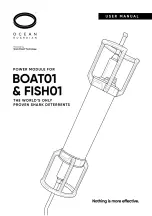
Page 19
PROTECTOR® IV Top of Rail Installation, Operation & Maintenance Manual
Solar Panel Maintenance
The solar panel is designed for trouble-free use and unattended operation. At most sites, rain will keep the
panel surface clean, thus preventing power output degradation. The lexan sheet is exceptionally resistant
to weathering as it will remain clear and non-yellowing for many years with minimal deterioration. The dirt
accumulation, which may be encountered in heavily populated areas, can be corrected by an occasional
cleaning with mild detergent.
On a yearly basis, as a preventative maintenance procedure, all bolts which fasten the panel should be tightened
to insure continued integrity of the system. All electrical connections in the junction box as well as the voltage
regulator should be inspected for tightness and for corrosion, especially in harsh environments.
As a measure of preventative maintenance, appropriate lightning protection should be installed as part of the
system in areas where lightning activity is a threat. This protection should follow standard railway procedures
and must be installed by the customer. The voltage regulators are equipped with surge arrestors which protect
their circuitry against induced voltages from lightning or other sources,
*+!$,%!$121(,&!$1$'()#.!$0(2"!,(,2$
strike
.
Distribution Hoses and Wiping Bars
Maintain wiping bar hoses and wiping bars on a weekly basis as follows:
1.
')*<&./&"&5$<$/1&>"3&4.#*@&.>#*3?*&)4*&83$%)$./&+.;$0*3&"#&$)&*+*31*#&83.+&)4*&5$<$/1&>"39
2.
C..T& ).& #**& )4")& )4*& V.5& $#& 2/$8.3+& 83.+& )4*& */)$3*& 6*/1)49& F)& "/(& <.$/)& 54*3*& )4*& +")*3$"6& ;.*#& /.)&
emerge, there may be a clog.
3. Insert a screwdriver under one end of the wiping bar seal.
4.
'6$;*&)4*&#%3*5;3$?*3&"6./1&)4*&3"$6@&#%3"<$/1&"5"(&"66&83$%)$./&+.;$0*3&)4")&4"#&"%%2+26")*;&./&)4*&3"$64*";9
5. Scrape both the area under the seal as well as the balance of the top of the railhead.
6. Lift the seal and use a putty knife to scrape excess material from the tip of the distribution blade and from
the “gutter” formed between the thin inner blade and the distribution blade.
7. Check the condition of the seal to see that it is staying tight to the railhead, is still supple and has good
“snap” to the rail.
8.
-6*"/&"5"(&*d%*##&83$%)$./&+.;$0*3&$/&.3;*3&).&+"$/)"$/&)4*&%./;$)$./&.8&)4*&#*"69
9. Repeat the above steps at the other bars. If one bar does not produce material there may be:
a) A clog inside the passageways of the wiping bar. Ordinarily, this would be a rare circumstance. Disassemble
that bar and clean all passageways; or
b) A problem with the check valve, located at the center of track distribution piping, between the ball valve
and the distribution hose. Remove and check for clogging.
W#$/1&"&<2))(&T/$8*&.3&.)4*3&V")&>6";*@&%6*"/&"/(&*d%*##&83$%)$./&+.;$0*3&83.+&)4*&0*6;&#$;*&.8&)4*&3"$64*";@&c2#)&
downstream from the wiping bars.
l3$%)$./&+.;$0*3&+")*3$"6&5$66&%.66*%)&"#&"&#*+$G#.6$;@&%"26TG6$T*&+")*3$"6&)4")&%"/&>*&<6"%*;&./&).<&.8&)4*&3"$6&
8.3&*S*%)$?*&%"33(G;.5/9
Recapturing waste material and keeping the site clean will help monitor future wastage and other changes in
the distribution and carry-down process.
















































